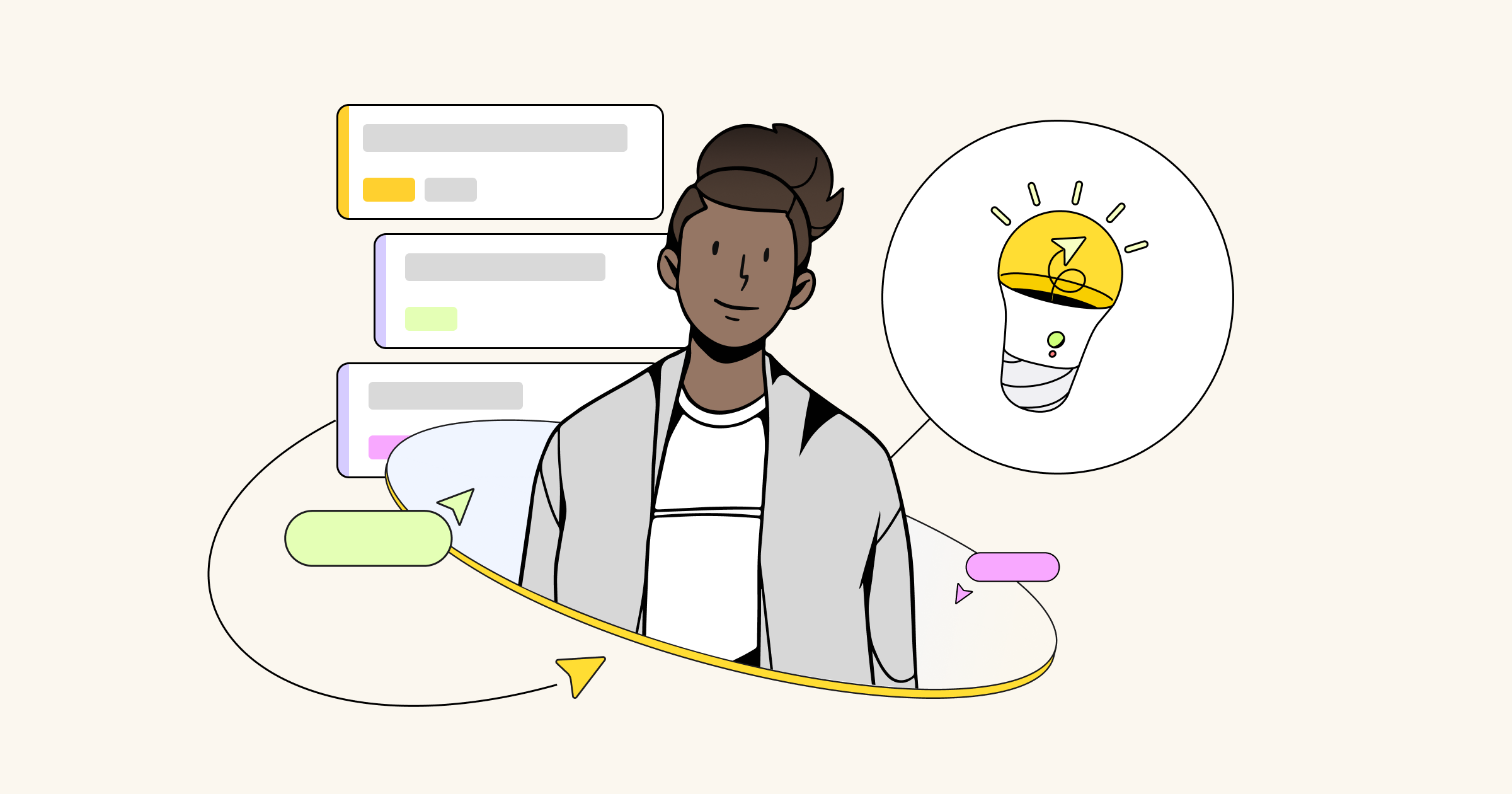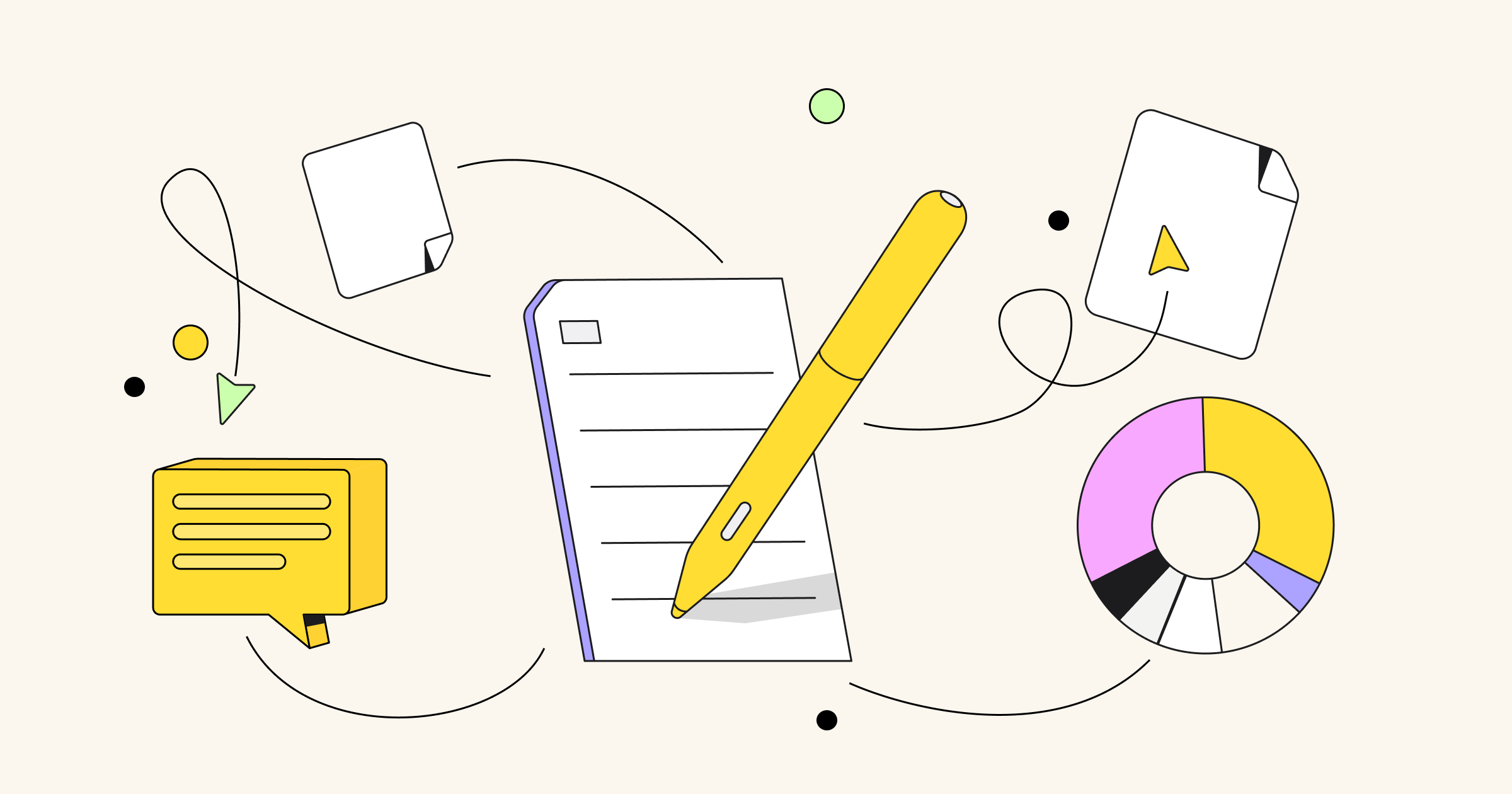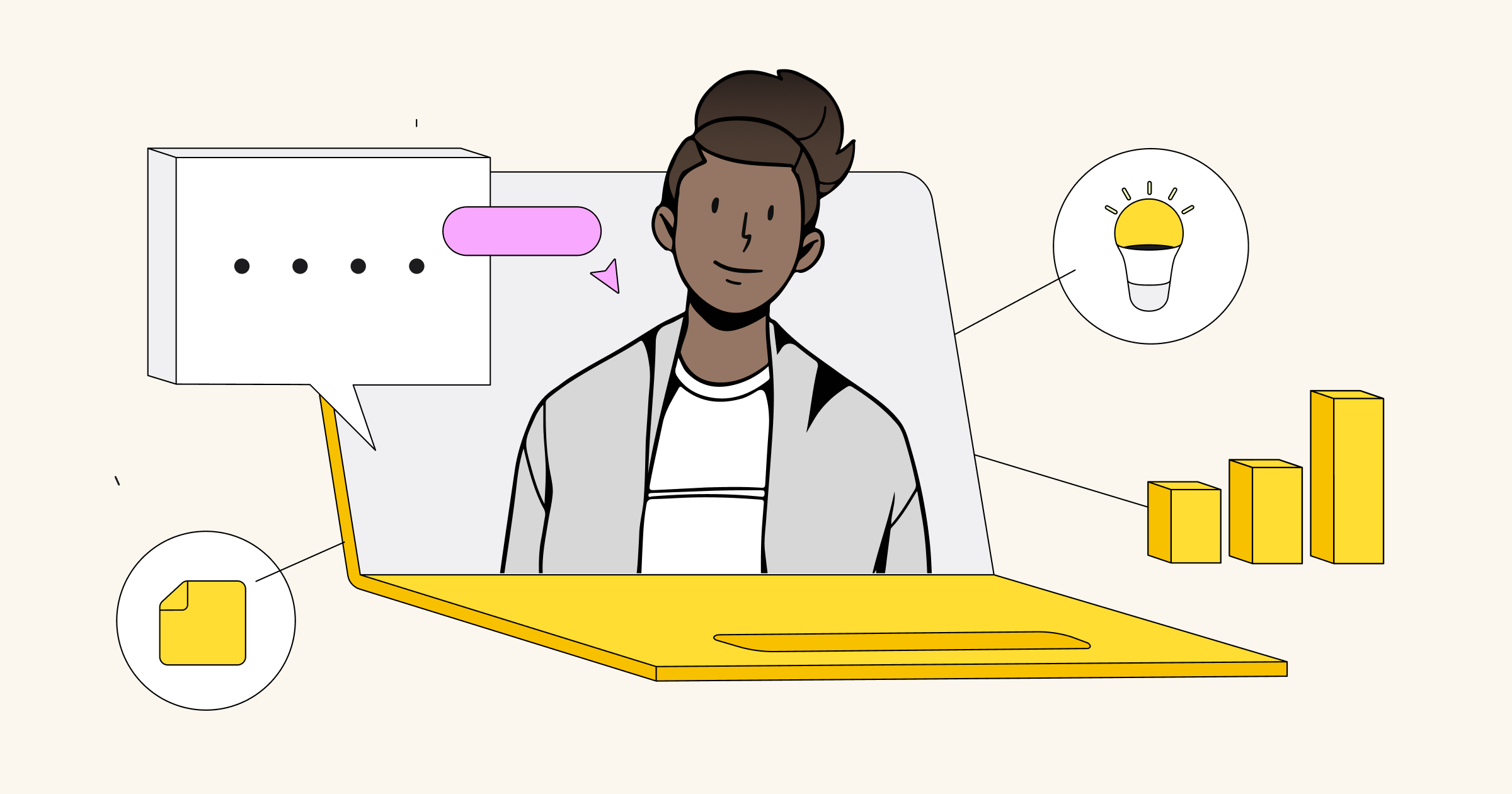You’ve created a stunning work of art, a product you’re extremely proud of. It took a lot of time, energy, and collaboration, but you got there in the end. You reach out to your client to tell them the good news.
“It’s great, but it’s not what we were looking for.”
All that hard work was for nothing, and now you have to start from square one feeling both defeated and deflated. It doesn’t have to be that way, though. Design thinking is a client-oriented approach to creative endeavors that can bring out the best in your efforts.
In this article, we’ll explain what design thinking is, the five stages of design thinking, and the benefits that design thinking can unlock for your business.
What is design thinking?
The design thinking process is the foundation of a lot of innovation and groundbreaking products and designs. Design thinking is more than just a way of generating and executing ideas; it’s a productive force for growth.

But what exactly is involved in the process?
Design thinking requires you to do away with conventional creative processes and instead use an iterative approach to move a project or product through various stages. That way, you can chip away at it and revisit it enough that you can be confident the end result will satisfy the end-user.
You can lean on design thinking to arrive at solutions to non-conventional problems. If you have a complicated task on your hands that needs to center around the user’s desires and feedback, then you can use the process to arrive at a solution that suits all.
It’s most useful for those problems where human interests are concerned since it’s a user-oriented problem-solving methodology.
At the startup level, design thinking can involve brainstorming sessions, prototype testing, and iterative processes. Whereas at the enterprise level, companies can model the IBM framework for design thinking (more on this later), which involves concepts such as playbacks, hills, and sponsor-users. These three concepts help enterprise employees to collaborate effectively even when their skill sets lie outside of creative fields.
Now that we’ve got your attention and your mind is buzzing from the possible applications of design thinking in your business let’s explore exactly what you could stand to gain from implementing it.
What are the benefits of design thinking?
Design thinking provides a framework for success, within which you can let your ideas flow. The methodology can lend structure to the chaos of creativity, streamlining the design process, so you can organize your team’s thoughts and build upon each other’s ideas.
The simple act of engaging in design thinking can serve to amplify employees’ creative voices, allowing them to express their ideas free from the rigidity of the standard work model. This is true at the level of the startup just as much as it is at the enterprise one.
Satisfied customers
Design thinking is a creative methodology that can transform a company’s process for product development. You can use it to build a system for idea generation and execution, thereby balancing art with science.
It also encourages those involved to develop their ideas with the end-user in mind to ensure they are anchored to a real-world context and don’t just rely on blind creativity to drive discussions.
As such, the process can establish a direct link between you (and your design team) and your customers.
It invites you to empathize deeply with your customer’s biggest concerns and desires so you can create the product they both want and need. By tapping into their conscious thoughts, you build a product that’s consumer-focused rather than one that appeals to you or your superiors.
Fresh ideas in conservative industries
With design thinking, it’s possible to update business practices and transform traditional work culture. Pancentric Digital, a digital agency that builds and hosts websites, saw the opportunities for innovation in the insurance industry.
The catalyst for this opportunity?
Understanding the customer’s needs and using tools such as user story mapping to create a clear picture of what they’re thinking. The user-focused element of design thinking allowed the designers within the agency to do what they do best while bringing the end-user into crystal clear focus, ultimately delivering a website that focused on their values and desires.
Before you begin
To ensure you put your best foot forward in the design thinking process, gather customer data ahead of time. Don’t take a stab in the dark; base your process on real information about your target customer.
Build a picture of your ideal buyer persona, and tailor your design process to it.
Whether or not you believe the old adage ‘the customer is always right,’ a product development process that excludes the end-user seldom leads to a product that flies off the shelves.
When you incorporate the customer at every stage of your decision-making process, whether it’s through user story mapping or using 5-whys analysis templates to get to the heart of customer concerns, you boost your chances of securing all-important sales.

As such, design thinking is a collaborative process that ultimately centers around the customer’s needs. No design thinking process would be complete without the following elements:
- Clarity – You can obtain clarity by painting a clear picture of your target customer from the outset, which can act as a compass, guiding the creative process.
- Collaboration – Subjectivity is often a cornerstone of poor design left unchecked. Even if it’s a one-person job, you need feedback to flourish. Ideally, this feedback would come directly from the end-user, which is a core element of IBM’s Enterprise Design Thinking model.
- Conviction – To carry a design idea through to completion, it’s important to commit to it 100%, leaving no stone unturned. Eliminate all options until you’re left with a polished idea. Open the floor to discussion so that every idea undergoes rigorous scrutiny and is less likely to be met with criticism from the end-user.
With these 3 C’s, you can guarantee that you won’t stray from the purpose of your design meetings. The design thinking process lays out a framework for success, but it should be clarity, collaboration, and conviction that underpin everything you do.
From the 3 C’s, we’ll move on to the 4 D framework before tackling the five stages of design thinking. While it may seem like a lot of numbers and letters to remember, it’s worth familiarizing yourself with the key ideas of the design thinking process to develop a deep understanding of how to execute it successfully.
What are the 4 Ds of design thinking?
The 4Ds framework is a simple way of visualizing the design thinking process.

Discover – In the discovery phase, your goal is to find out what the end-user really wants from the product or service you’re developing. Since design thinking is a user-oriented approach, you need to ensure you not only understand your customers but that they become an integral part of your working process.
Define – Next, you need to define what your most significant challenges will be and how to prioritize them. Evaluate the information you’ve gathered and use aids such as the bull’s eye diagram to pin down the most important problems.
Develop – Development is all about brainstorming possible solutions, using whatever techniques work best for you. Finding a brainstorming template can be an excellent way to start if you’re struggling for ideas.
Deliver – Finally, the delivery phase is where you’ll produce your initial prototype and test it to see how well it aligns with your customer’s needs. From this phase, you can circle back if the idea doesn’t pan out and you need to try out a similar or new idea.
The 5 stages of design thinking
As with any good creative process, design thinking has a framework that you can use to easily implement the practices into your business. That’s what separates a concept like design thinking from the vague idea of creative thinking: it’s made up of several key stages.
These five stages align closely with the 4Ds model, but the ‘Develop’ stage is more nuanced. It’s expected that this stage may be iterative and will loop through a process of ideation, prototyping, and testing several times over.

1. Empathize
Underpinning the whole design thinking process is empathy. Without it, you’ll have nowhere to channel all your creative energy and ideas. Empathy is the link between you and your customers, and it’s essential for driving user-focused product development.
Use empathy to strike a chord with your audience by gaining an appreciation for the end-user’s interests and preferences. Go beyond discussions of ‘what might work’ and ‘how great it would be if…’ and move towards user-centric thinking defined by a commitment to provide the best possible product for the person who will buy it.
On a practical level, this is the stage where you should collect relevant information about your users. Research what pain points your customers grapple with on a regular basis and how your product can alleviate or ease them.
2. Define
The next stage of the process is about clearly defining the problem you’re trying to solve. This is only possible once you’ve gathered data about your customers. While it may be a creative process, design thinking should be driven by data to ensure that you never deviate from an end-user focus.
During this stage, you’ll want to come up with a statement that outlines, in as much detail as possible, the pain points you’re seeking to address with your product. For example, if you’re creating a project management tool, you could define the problem like this:
Managers at all levels need a system to organize employees, delegate tasks, and oversee project progress.
Now you have a clear goal to work towards and a statement to remember throughout the process to steer you in the right direction.
3. Ideate
Now it’s time for the fun part, where you unleash your creativity and brainstorm ideas. Whereas many brainstorming sessions start with a seed of an idea or an assumption of what might work, the ideation stage of the design thinking process will be guided by a foundational empathy for the customer’s problems and a clear definition of these problems.
You’re channeling creative energy in a focused environment rather than letting it spill out into unrelated territory. During ideation, you might rely on any number of techniques, from the standard brainstorming or mind-mapping session to creative exercises such as ‘Worst Possible Idea.’
4. Prototype
Once you’ve spent time at the drawing board, developing ideas and shortlisting those most likely to satisfy your problem, it’s time to single out the best solution for prototyping. During this stage, you’ll create a working prototype that will put your ideas to the test and see if it makes for a viable product.
You can then share the prototype among the design team and further afield, inviting feedback from different departments and making sure it’s the best product it could be. If necessary, you can create prototypes for several of the ideas you came up with during the ideation stage to see which ones are most effective for solving the problem you identified.
5. Test
Finally, you’ll need to put your product through its paces to ensure optimal quality. Once you have a product that you’re happy satisfies the problem you defined, carry out quality management to diagnose any potential design flaws that could negatively impact its release.
It’s entirely possible that during the test phase, even if you execute the design thinking process flawlessly, you’re unsatisfied with the product, or the product sparks ideas for alternatives. In this case, it’s important not to have your ego tied up in any particular product.
If there’s an idea for a potentially greater alternative, it’s worth going back to the drawing board and starting over from the ideation phase to explore the potential of the new idea. That way, when you eventually release your product, you’ll rest assured knowing you’ve exhausted all viable options.
Examples of design thinking at work
Now that we’ve covered the theoretical underpinnings of the design thinking process let’s take a look at how it manifests in practice.
Businesses such as Upwork and IBM have transformed their results with design thinking, so there’s every reason to believe it can work for your company, too. Let’s take a look at how design thinking has driven success at the level of the medium-sized company and the large enterprise, so you can see exactly what it is and its role in every size of business.
The medium-sized company: Upwork
Upwork is a freelance platform that serves as an intermediary between freelancers and clients. Through the website, freelancers can search through jobs posted by clients and work with the assurance of a secure payment system and business support.
To “Inspire a Boundless Future of Work”— which is what management at the company set out to do — there’s a need for innovation and non-linear thinking. Yet, the challenge for Upwork lay in implementing a system of design thinking across an organization that has remote teams based around the world.
The solution?
Senior management at Upwork sought to drive innovation by making the most of Miro’s collaborative workspace.
The User Flow Template, for example, allowed the remote teams at Upwork to reliably develop empathy for the customer’s needs. The Bull’s Eye Diagram Template allowed them to hone in on specific goals to set priorities, and the visual workspace as a canvas for expression and active virtual brainstorming sessions among team members.

The Enterprise: IBM
For tech giant IBM, design thinking formed a crucial part of its business strategy, to the extent that the company now offers courses and certifications in Enterprise Design Thinking.
The problem IBM faced was integrating design thinking practices at scale. The problem-solving process had shown promise for many smaller companies, yet it didn’t have the same impact for titans of the industry. That’s why Adam Cutler, the brains behind IBM’s Enterprise Design Thinking program, met with IDEO CEO, Tim Brown, to discuss the design thinking practice and how it could be effectively applied to the enterprise business model.
There was also the idea that the design thinking process was at odds with your average IBM engineer, who was driven by logic and solutions. As such, Cutler had to find a way to implement the core creative tenets of design thinking in a logic-focused enterprise. At the core of this enterprise-driven approach were three constructs:
Playbacks
Playbacks are regular design sessions that do away with hierarchy and encourage a level playing field. During these sessions, feedback was welcomed, and suggestions were encouraged. Constructive criticism allows employees to build upon one another’s ideas and reach a satisfactory solution for all parties.
Hills
Hills are defined as statements of intent, made up of three sentences. The statements place the user at the heart of the creative process and take the form of user stories that provide direction to discussions about how to improve design features.
Sponsor-users
Sponsor-users are end-users from clients that have an active involvement in the design process, offering outside input and an authentic user voice to ensure discussions revolve around the main issues users face.
IBM’s success with design thinking goes to show that the creative process isn’t just reserved for startups looking for that hit of inspiration that propels them to financial success. It can also be effective for the large enterprise, injecting fresh energy into traditional models and breeding innovative practices that bring the company forward.
How to put design thinking into action with Miro
Miro’s design thinking templates provide pre-made frameworks for various creative processes.

For example, the Customer Problem Statement Template really helps with the ‘Define’ stage of design-thinking. With this template, teams can quickly get to the heart of the problem customers are facing and use that information to shape the ‘Ideate’ phase more effectively.
Using pre-made templates cuts down on the time it takes to work through the phases of design-thinking and provides a structure for organizing thoughts as they arise.
This enables teams to focus their effort on developing the perfect customer-centric solution rather than getting bogged down in the detail of administering a process.
Plus, as all of Miro’s templates sit within its larger digital ecosystem, team members can access, collaborate, and refine their work both from the office or virtually, wherever they are in the world.
Miro’s design thinking templates provide the perfect framework for the creative process, so if you’re curious about how you can replicate these results, follow these steps:
Step 1: Gather all of the relevant resources that pertain to the project at hand. This could include anything from market research for your new product to a description of your ideal buyer persona.
Step 2: Get started by selecting the template that aligns best with your goals. If you’re creating an ad, storyboard templates can help you develop your narrative. If you’re looking for a visual representation of all the tasks on your company’s to-do list, try the ‘Jobs to be Done’ template.
Step 3: Assemble your A-team and start working on your most pressing tasks. Use the template as a canvas, guiding the creative process and allowing effective collaboration and feedback.
Let design thinking bring structure to your creative processes
Fostering a design thinking culture can bring teams together and lead to synergistic thinking and ideation. Implement design thinking if you want to create brilliant products that not only show off your style but also serve the client’s needs.
You don’t have to supercharge your product development with unbridled creativity; a framework such as that proposed by the design thinking process can ensure you hit your design goals while also infusing a healthy dose of creative energy into your efforts.
Make the most of design thinking by using Miro’s templates and collaboration tools to supercharge productivity and drive creativity that sells — get started for free.






